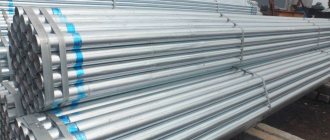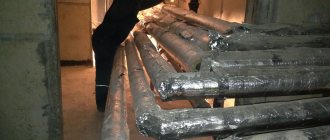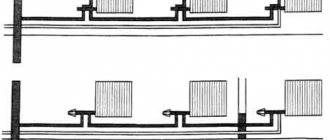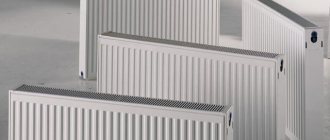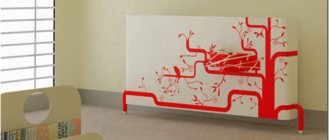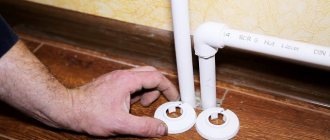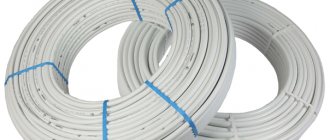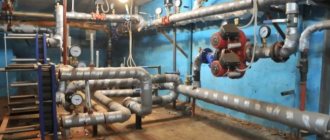Advantages and disadvantages of heating registers
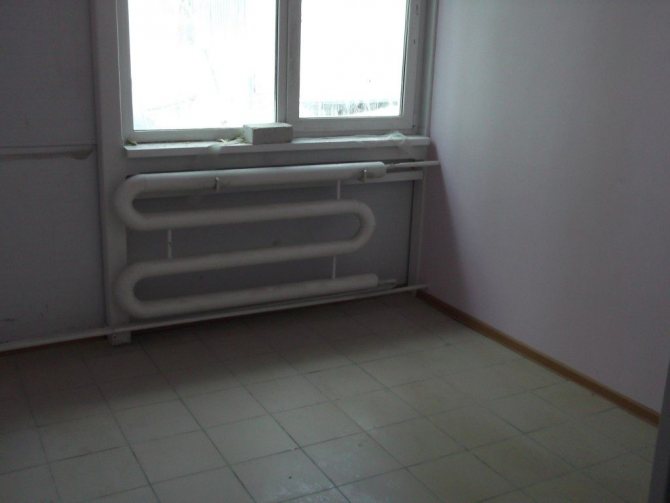
Registers in the heating system
Homemade steel or aluminum heating registers differ from standard radiators in their dimensions. They consist of several pipes with a diameter exceeding 32 mm. To organize the circulation of the coolant, the pipes are interconnected by branch pipes.
What is the reason for the popularity of these heat supply devices? Firstly, the possibility of self-production. You can make bimetallic heating registers, steel or aluminum pipes. Plastic models are much less common, since they do not have the proper performance.
Before connecting the heating registers, you should carefully study their "weak" and "strong" sides.
Benefits of using:
- Long service life... For steel and aluminum models, it can be up to 25 years. In this case, the probability of breakage will be minimal;
- Great heat dissipation... This is due to the fact that the power of the heating register exceeds this parameter for classic radiators and batteries. Associated with a large volume of coolant;
- Simple installation and operation... Since the heating registers can be correctly installed by anyone who is at least a little familiar with the rules for organizing heat supply, they can be used in buildings of all types. But most often they can be found in the heating system of large industrial, administrative and commercial premises.
But besides this, you need to take into account the possible disadvantages that a heating register from a smooth steel pipe may have:
- Large volume of coolant... This leads to its rapid cooling;
- Minimum air convection rate... Reduces the efficiency of heat supply;
- Unattractive appearance... Most often this applies to self-made structures.
Correctly calculated heat transfer of the heating register directly depends on its design. Currently, several types of these heat supply devices are used, differing not only in the used material of manufacture, but also in appearance.
The weight of the register filled with water can be very high. Therefore, you need to think in advance about a reliable system for attaching it to the wall.
Determination of device power
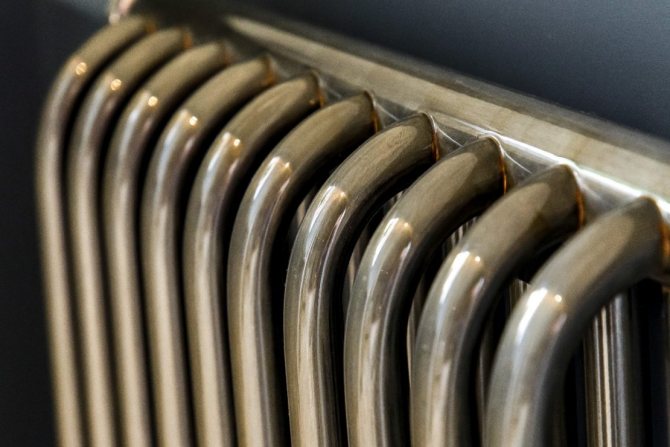

Characteristics and dimensions of steel heating radiators
To calculate the power of the radiator, you need indicators:
- comfortable temperature conditions in the room;
- room area;
- the height of the walls;
- the number of windows in the floor;
- the degree of insulation of an apartment or house.
To take into account all factors, the formula is used: Q = St x K x t, where: Q is the thermal power of the pipe; St (m²) - heat exchange area; K is an indicator of the coefficient of the level of heat transfer of a steel pipe (this parameter is equal to 11.63 W / m²x ° C); t is the size of the thermal head.
Now how to find indicators:
- Heat exchange area. Calculate the circumference of the pipe at the outer edge and multiply by the length of the section.
- Thermal head. Find half the sum of the temperatures in the supply and return pipes, then subtract the indicator of the comfort mode in the room. For example: in the supply pipe +95 C, in the return pipe +70 C. The desired heating level is +25 C. The total is = (95 + 70) / 2) - 25. As a result, 57.5 is the desired thermal head in one segment register.
Important! In the parallel connection registers, the movement of the coolant is sequential. The heat transfer of each next pipe section is 10% lower than the previous one. Therefore, all miscalculations should be made with the correction for reducing the power level of the sections by 10%.
Heating register types


Heating register types
Initially, you should decide on the type of construction. After all, how to calculate the heating register if its geometric parameters and the principle of circulation of the coolant are not known? For the manufacture of heating devices, it is recommended to use standard proven schemes.
The defining parameter of the choice is the required circulation rate of the coolant in the system and the degree of heat transfer from the register. Based on these requirements, you can choose two types of heating devices:
- Sectional... It consists of two or more large diameter pipes connected by pipes. The cross-section of the latter should be equal to the same parameter of the supply line. The selection of a heating register of this type is relevant for systems with forced circulation, since excessive hydraulic resistance is created in the structure when the coolant passes;
- Serpentine... They consist of one pipe that has bends. Making such homemade heating registers is problematic. To increase the circulation rate, pipes can be connected with pipes. But this is optional as in the above models.
Since you can make a heating register with your own hands even at home - they are often made, and not purchased ready-made models. But before that, the correct calculation of the power of the heating register should be performed.
For the manufacture of registers, you can use pipes of various sections - round, rectangular or square. Preference is given to the first, since for them the water friction during movement will be minimal.
The algorithm used to create
- First, pipes of the required volume are prepared and cut into workpieces of the required length.
- After that, the internal cleaning of pipe-rolling products is performed. This makes it possible to reduce the resistance to movement of the heat carrier.
- Caps are welded on the end parts. Some of them are equipped with holes.
- After that, the pipes, which will be located horizontally, are fastened to the vertical pipes, which have a smaller diameter.
- Now it's time to install the taps. They will be needed in order to release the air accumulated in the pipeline.
- At the final stage, all seams are cleaned and the surfaces are painted with paint.
Calculation of heating registers
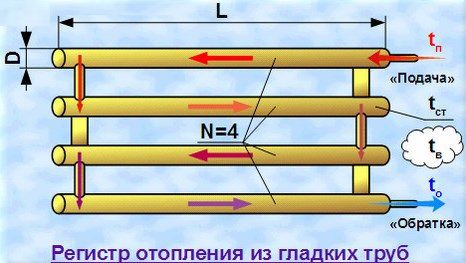

Heating register operation
There are several methods for calculating the parameters of heating registers. They are distinguished by the accuracy of calculations and laboriousness. But for the organization of heat supply using steel or aluminum heating registers, it is recommended to resort to the services of professionals. An alternative option is to use special software.
However, in some cases, it is necessary to correctly calculate the heating register yourself. To do this, you can use a simplified diagram. You must first know the following parameters:
- The total area of the heated room;
- Heat transfer coefficient of register material;
- The diameter of the pipes used for manufacturing.
For pipes with a circular cross-section, the calculation of the specific power of the heating register can be done according to the data in the table. These values are given for 1 lm. register pipes.
| Diameter, pipes, m | 25 | 32 | 40 | 57 | 76 | 89 | 110 |
| Room area, m2 | 0,5 | 0,56 | 0,69 | 0,94 | 1,19 | 1,37 | 1,66 |
However, this method of selecting the heating register has a number of significant disadvantages. The data are given for rooms where the ceiling height does not exceed 3 lm, the thermal mode of the system operation and the air temperature in the room are not taken into account.
For more accurate calculations, it is recommended to use the formula:
Q = P * D * L * K * Δt
Where Q - specific thermal power, W, P - number π - 3.14, D - pipe diameter, m., L - length of one section, m, TO - coefficient of thermal conductivity. For metal, this figure is 11.63 W / m2 * C, Δt - the temperature difference between the coolant and the air in the room.
Knowing these parameters, you can independently calculate the power of the heating register. Let's assume that the length of one section is 2 m and the pipe diameter is 76 mm. Δt is 60 ° C (80-20). In this case, the power of one section of the heating register from a smooth steel pipe will be equal to:
Q = 3.14 * 0.076 * 2 * 11.63 * 60 = 333 W
To calculate each subsequent section of the device, the result obtained must be multiplied by a reduction factor of 0.9.
Using this technique, ribbed heating registers cannot be calculated. Their heat transfer will be higher due to the increased area of the device.
Ribbed steel registers
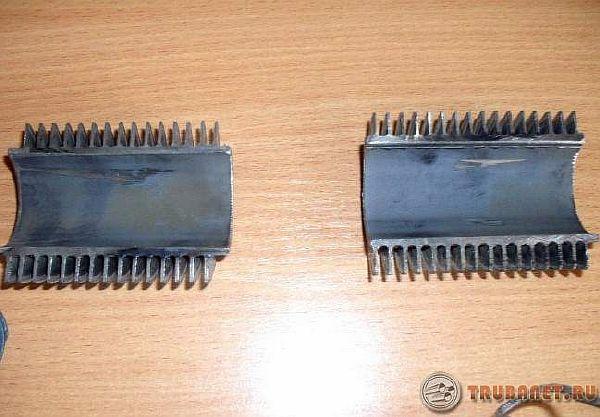

Before installing registers from steel pipes with ribs, it is recommended that the main attention be paid to the volume of the pipe. For a private house, masters advise installations with a volume of 3 or 4 centimeters.
Video
You can take pipe rolls of a larger diameter for work, but it should not exceed 8 centimeters. The main reason lies in the heating boiler. A device of the type that is installed in everyday life cannot generate a large amount of thermal energy, sufficient to heat bulk areas.
When performing calculations, you need to take into account the length of one edge of the register and its heat transfer per square meter. If you give an example, then a meter-long pipe with a cross-section of 60 mm inside can heat approximately one square meter.
Having counted the required number of registers, rounding is carried out in the direction of increase. But, there are certain conditions under which the obtained indicators increase by 20, and even 50 percent. This includes:
- The presence in the room of a large number of openings for windows and doors.
- Small wall thickness.
- Low-quality insulation of the room, or its complete absence.
A simple heating register has less heat transfer than devices with fins. They not only increase heat transfer, but also turn the register into a design - a radiator that can play an important role in the aesthetic solution of the interior.
Choosing the material of manufacture for the registers
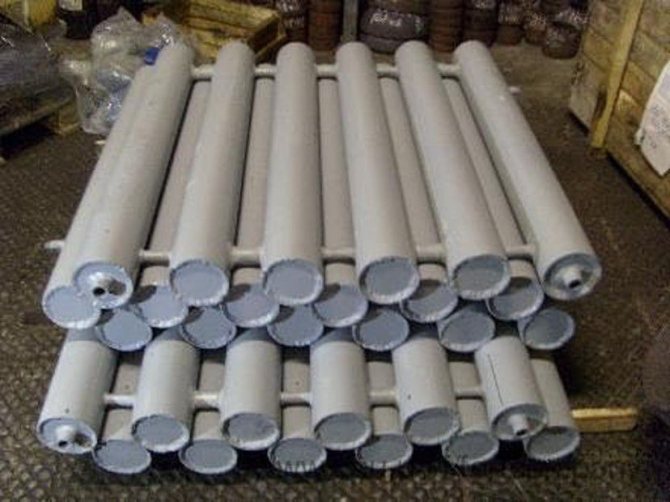

Steel heating registers
The next parameter that must be taken into account when choosing a register is the material of its manufacture.
It is rare to find heating registers from a profile pipe - most often steel products of a circular cross-section are used for this.
Currently, several materials are used for the production of registers - metal, aluminum or bimetallic pipes.
The difference between it lies in the calculated heat transfer and service life:
- Steel heating registers from a profile pipe or round section... They are characterized by simplicity of manufacture and low cost. The disadvantage is surface rusting. When choosing, special attention should be paid to the quality of welds;
- Aluminum... They are extremely rare, since special equipment is required for welding aluminum heating registers. But on the other hand, they have the best thermal conductivity. There is virtually no heat loss;
- Bimetallic... They are made from a special type of heating pipes. They have a core made of steel. To increase the heating area, the design has copper or aluminum plate heat exchangers. All bimetallic heating registers are characterized by a small pipe diameter - up to 50 mm. Therefore, they are more often used to organize heat supply in residential buildings and small industrial and commercial premises.
The material of manufacture directly affects the calculation of the heating register. The main indicator in this case is the coefficient of thermal conductivity. Despite the fact that aluminum models have an optimal value - their high cost and laboriousness of manufacture do not allow the use of registers of this type in heating systems everywhere.
For the manufacture of ribbed heating registers, you can use accessories from steel radiators.
Making registers for heating with your own hands
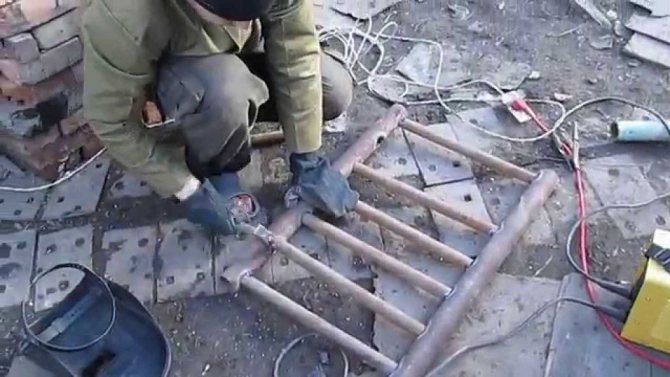

Heating register production
One of the advantages of using registers in heating systems is the possibility of their own production.For this, steel pipes of circular cross-section are most often used. Despite the fact that the heat transfer rate of the heating register in this case will not be ideal, the manufacturing process does not require special skills.
For self-production of this heating element, you will need a pipe with a diameter of 40 to 70 mm. A larger cross-sectional value will lead to significant heat losses during the circulation of the coolant. You can make a heating register with your own hands according to the following work scheme:
- Calculation of the optimal parameters of the heating device - the diameter of the pipe, the total length of the section.
- Drawing up a drawing to calculate the optimal amount of material.
- Do-it-yourself work on the manufacture of a heating register.
- Checking the structure for leaks.
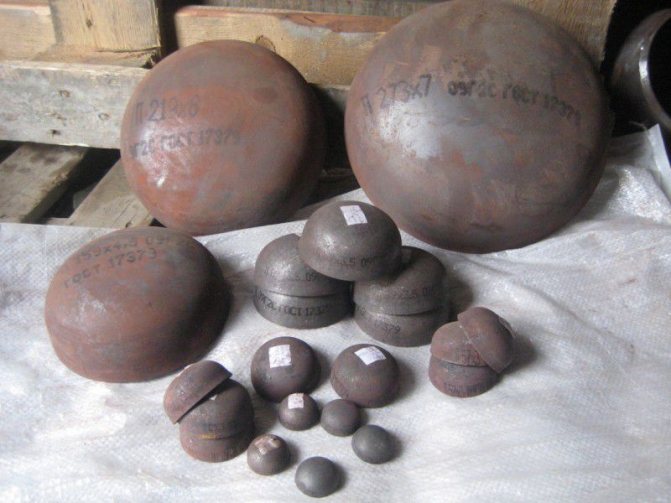

Steel pipe plugs
To accomplish this task, you will need a steel pipe designed to form the main registers and a line with a smaller diameter. With its help, the registers will be connected to each other and the heating system. You will also need special pipe end caps.
At the first stage, it is necessary to cut the pipes to the required length using a grinder. It is not recommended to use a welding machine for this, since an overlap will form at the ends of the heating register from a round pipe. Then holes are made for connecting the branch pipes. The nozzles are welded on with a welding machine and end caps are mounted. To ensure the safety of the operation of a homemade heating register, it is necessary to install an air vent and a drain valve. They are mounted in the upper part of the structure, but on the opposite side relative to the heating connection point.
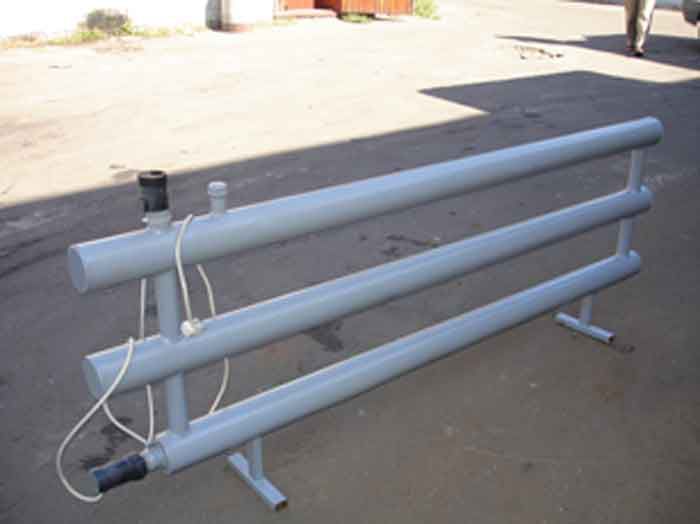

Heating register with heating element
In some cases, the modernization of the traditional scheme of the steel or bimetallic heating register is carried out. It consists in installing an electric heating element.
So you can make an autonomous heat source, which will not depend on the operation of hot water heating. In the event of an accident or technical work, a self-made heating register will generate heat using a heating element. But for this, shut-off valves should be installed during installation so that the coolant circulates only inside the heater.
During the selection of the scheme and the manufacture of the heating register, the thickness of the pipe does not matter. The difference in diameters between it and the supply line determines the complete absence of water hammer in the structure.
Radiator manufacturing instructions
To make a heating register with your own hands, it is recommended to initially carry out the necessary calculations (the methodology above in the text). And it's not about saving resources, but about making batteries really useful in all respects.
Experiencing the winter period with open vents - this option is suitable for "walruses". Everyone else outside the hardened group runs the risk of getting a serious cold. And powerful radiators are as bad as too weak.
Hand-made pipe register for heating. This design of the heating battery is distinguished by a non-standard coolant supply. Water is supplied and discharged through pipe risers, to which the register pipes are directly connected
So, the calculation is done, you can start choosing the material.
An economical and quite suitable choice for a home-made construction can be considered steel pipes and fittings produced for steel pipes:
- bends (suitable for the diameter of the pipes);
- corners (reinforcement);
- steel sheet (thickness is equal to the thickness of the pipe wall);
- branch pipes (small diameter pipes).
Gates may also be required, which are often not placed directly on the registers. Skills in production and knowledge of gas welding technology would be useful if the future performer possesses them.
According to the calculated length parameters, the pipes of the future radiator are cut to size. A handy tool for cutting is a circular saw. Then, plugs are cut out of the metal sheet for the ends of the pipes. The round shape of the plug is convenient to cut with an oxygen cutter.
First of all, circles of the required diameter are marked on the surface of a metal sheet with chalk and then carefully cut. Some of the sliced pancakes (the amount is calculated) are made with holes for the inlet and outlet pipes of the coolant.
Factory-made caps for register pipes. Such plugs are preferable for installation in do-it-yourself batteries. A varied assortment provides opportunities for a wide selection
It is also immediately recommended to cut holes (one or two, depending on the assembly project) in the wall of each pipe, with an indent from the end edge by 100 - 150 mm. These holes are for loop-through pipe connections during battery assembly.
We suggest that you familiarize yourself with the height of the boiler room pipe in a private house
After cutting the holes, it is recommended to clean the inner area of each pipe from slag and scale. Next, pancakes are placed on the ends of the pipes and scalded in a high quality circle. On the first and last pipe, one pancake with a hole is brewed.
Finished pipes must be combined into a battery. For this, the configuration of the radiator is determined (if it is decided to make a lattice structure). Based on the accepted choice of configuration, jumpers are prepared - through and blind.
The material for the lintels is usually small diameter pipes. For example, d = 25 mm or d = 32 mm. Also prepare pipes for supply / return pipes (length 150 - 200 mm, diameter 25 - 32 mm).
Do-it-yourself heating register assembly. For ease of fitting and accurate installation, the workpieces are placed on a flat surface. In this case, all the details are laid on a stone platform.
Pipes prepared for the heating register (2 - 3 - 4) are laid out on a flat surface, aligned along the end edges. The first (top) and the last (bottom) are laid out with end edges with holes, according to the selected connection scheme: one-sided (inlet and outlet on one side) or double-sided (inlet and outlet on opposite sides).
It remains only to carefully weld the pass-through and blind jumpers between the pipes, the inlet and outlet pipes, after which the heating register is ready for installation into the system. Before work, a novice master will need to study the rules of electric welding, described in detail in an article devoted to this issue.
The serpentine register is assembled a little differently. Here, instead of vertical bridges, metal bends are used, with the help of which the end parts of individual pipes are connected.
To assemble the register with a snake, you need:
- Lay the pipes out on a flat surface.
- Weld arc bends from paired 45º bends.
- Connect the paired register pipes on each side with arc branches.
- Close the initial and end ends of the first and last pipes with plugs with branch pipes.
Coil heating registers are large-sized due to the limitation of the possibility of adjusting the annular distance. In this regard, "snakes" are superior in parameters to lattice structures. However, from the point of view of the efficiency of the coolant stroke, the "snake" looks like a more preferable option.
An interesting example of a coil register, made not by oneself, but at the factory. Industrial production conditions make it possible to make more advanced devices (with ribs that dissipate heat)
Inside such registers, air locks are practically not formed, which is typical for products of the "lattice" type. In addition, due to the large diameter arc branches, the coil structures have a lower hydraulic resistance.Nevertheless, they rarely make such registers with their own hands.
An interesting design in comparison with those described above is a register made of a shaped pipe. More compact, but no less efficient batteries are assembled using practically the same technology.
The features of the assembly can be noted only for the preparation and adjustment of the intertube bulkheads. As a rule, welding is not used here. It is enough to have a good metal-cutting tool.
An example of manufacturing a heat register from shaped pipes. The snake design is more compact than smooth round pipes. Meanwhile, the efficiency of the device on shaped pipes is no worse than traditional
The ends of the intertube lintels and the register pipes directly are cut at an angle of 45º, achieving an exact match along the edges on the connection line. If the register is being assembled as "lattice", the intertube bulkhead is made with angular cuts along the ends and straight cuts along the supply points of the central pipes.
This is how a register heating battery is obtained, made according to the grid scheme. Neat appearance and quite convenient shape for installation in a domestic environment
After preparation, the jumpers are put in place and carefully scalded. On the "snakes", they additionally put blind reinforcing jumpers parallel to the bushing.
Homemade registers were widely used for household needs in the recent past. Now this type of heating device is used less often.
An alternative to registers, especially if the garage is not connected to a centralized heating system, is a miracle diesel stove. The article proposed by us will acquaint with the method of its manufacture.
Installation of registers in the heating system
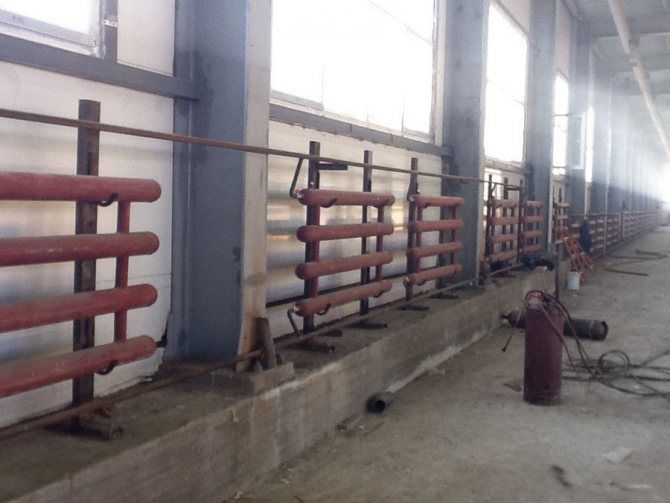

Heating registers in the production area
Correct installation of heating registers can be carried out in two ways - on threaded connections or using a welding machine. It all depends on the total weight of the structure, its dimensions and the parameters of the heat supply system.
In general, experts recommend following the same rules as when installing radiators. The difference lies only in the size of the structure. If it is necessary to connect the heating register to the gravitational system, the required slope indicator must be observed. The heat supply device should be tilted towards the direction of movement of the heat carrier. There are no such requirements for systems with natural circulation.
For the correct installation of heating registers, the following rules must be followed:
- Compliance with the minimum distances from the wall and window structures. It must be at least 20 cm. This is necessary for carrying out technical or repair measures;
- For the threaded connection of the heating register, only paranite linings or sanitary flax are used;
- All heating registers made of profile or steel pipes must be painted. This is necessary to prevent the appearance of rust on their surface.
Despite the fact that the heat transfer rate of the heating register will decrease, the period of the maintenance-free service of the structure will significantly increase.
Installation is recommended outside the heating season. After a trial run of the heating system, you can compare the calculated power of the register with the actual one and, if necessary, make operational changes to the design.
Combined devices
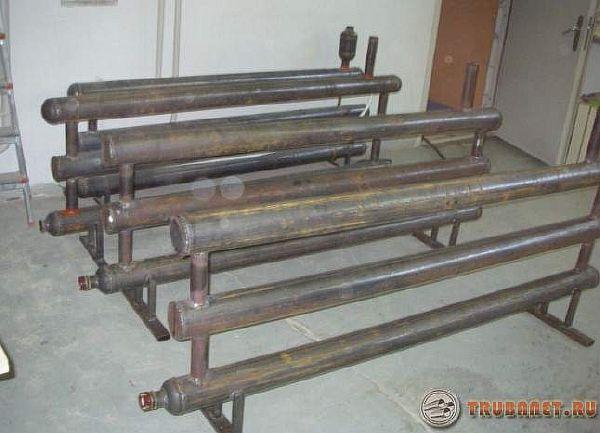

Any device can be supplemented with a heating element, in this way a combined heating device is obtained. It may not be associated with the system, and can be applied separately.
If this is an isolated register with heating only from the heating element, then an expansion tank must be installed in its upper part. Its capacity should not be less than 10% of the capacity of the heating device. For steel registers, closed tanks should be installed.
Such steel structures help out perfectly in very cold weather, when the heating capacity from the boiler becomes scarce. This option is also very practical during the off-season, when it is not advisable to use the network at full capacity. After all, the room at this time only needs a little warming up.
Heat dissipation registers
Heat transfer from steel pipe registers is the transfer of heat energy between the battery and the environment. Heating devices made of smooth pipes are less economical.
The heat output of one meter of these structures is approximately 550 W, for a diameter of 3.2 to 21.9 cm. Welding work on installation is recommended to be carried out so that there is no mutual heating of the elements.
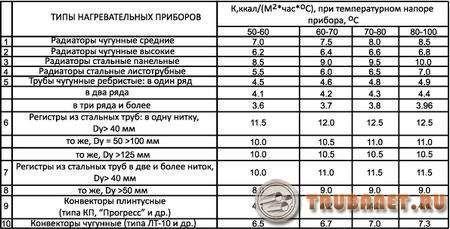

Under such conditions, the heat transfer rate becomes higher. If the register is assembled correctly, then it becomes a reliable and durable steel heating device. Optimization of heat transfer of a steel pipeline is decided at the design stage of its structure. To do this, use such methods.
- Change of infrared radiation in the direction of magnification. This can be done with paint.
- The ribs are installed, which also increases the required structural performance.
But, there are cases when these indicators need to be reduced. Such actions are required by sections of the pipeline that pass outside residential premises. In these situations, the line is insulated.
Calculations are carried out as follows: Q = K * F * dT. In this formula, Q denotes the heat transfer coefficient, K is the thermal conductivity of steel materials, and F shows the length of the pipe taken for calculations. dT in this formula is the sum of the initial and residual temperatures, taking into account the room temperature.
Video
The dT designation is also called the temperature head. You can find it out by adding the temperature at the outlet of the boiler equipment with the numbers at its inlet. The readings obtained are multiplied by 0.5 or divided by two. The room temperature is subtracted from this value.
If the steel heating pipeline is in an insulating material, then the resulting number should be multiplied by the efficiency of the insulation material. It shows the percentage of the heat energy of the heating system given off during the flow of the heat carrier.
If there is a desire to design the system correctly, then it is not worth choosing a pipe-rolling assortment from steel by eye. Correct calculations in this case not only make it possible to reduce the cost of construction work, but also to install a heating system that will work effectively for a long time.
Installation of steel registers
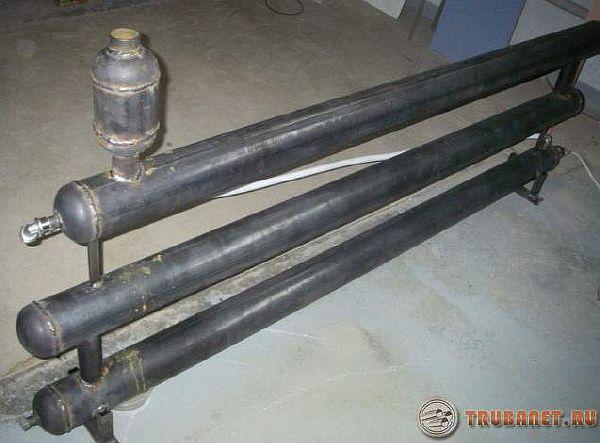

Installation of steel pipe registers is done in two ways. The first is threaded connections, and the second is by welding. In this matter, solutions are selected based on the total weight of the structure, on its dimensions and characteristics.
The process itself is similar to the work when connecting radiators. The only difference is in the geometric volumes of the structure. If there is a question of bringing the heating device to the gravitational networks, then the required slope norms must be observed.
The register should be inclined towards the movement of the heat carrier. For a line with natural circulation, the described norms are not necessary.
The rules that are used for the correct connection of steel pipe structures are as follows:
- The minimum distance from windows and walls should be observed. This distance is 20 cm. These indents are needed for the convenience of repair service.
- When using threaded connections for connecting the device, it is recommended to use only paronite gaskets, or flax, which is used in plumbing work.
- Each steel appliance must be painted after installation. Otherwise, rust can form on its surface very quickly.At the same time, the thermal conductivity index is slightly reduced, but the period of its maintenance-free service is extended.
- All installation work should not be planned for the heating season. After a trial check and comparison of the calculated power of the device, it may be necessary to promptly make changes to the design.
Video
Of the installation features, two more mounting options can be distinguished. The first is by hanging the device on the wall, and the second is by attaching it to the racks. The solution in this situation depends on the weight and dimensions of the device and on the type of walls.
The combined version of the construction fasteners has gained great popularity. To do this, first prepare the racks, and then they are attached to the walls.
This method is suitable even for very heavy heating devices and guarantees a high safety index. We must not forget about air vents, they are added to every heating device. The collected air is released from the line through the air vent.

